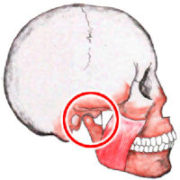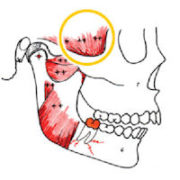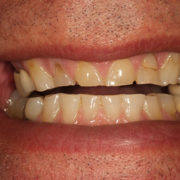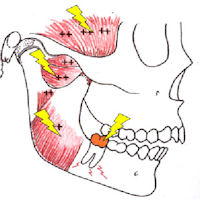
The Most Common Type of Facial Pain
Occluso-Muscle Pain
You may find it baffling to understand, but the most common type of facial pain is also the most undiagnosed type of facial pain. It is also the most mistreated type of facial pain. And what makes this scenario even harder to understand is that Occluso-muscle pain is one of the most predictably treatable types of pain if properly diagnosed.
Occluso-muscle pain can be explained as pain in the masticatory muscles that is triggered by disharmony between the teeth and the jaw joints.
The masticatory muscles include all the muscles that move the jaw in closing, opening, chewing, talking and all movements made by the lower jaw. A very important part of a thorough dental examination is to check for any tender, hyperactive, or spastic masticatory muscles because although muscle pain can be caused by a number of different disorders or diseases, sore jaw muscles are more often than not a direct result of disharmony between the bite and the jaw joints. In fact, the goals of good dental treatment should always include achieving a peaceful neuromuscular system in the face and jaw. Let’s explain what that means and then we can show you how a bad bite can disrupt peaceful muscles and cause pain.
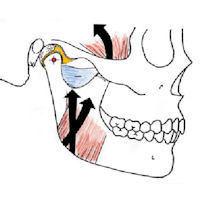 Your masticatory musculature was designed to function in a very orderly and synchronized manner. This orderly function is said to be coordinated. This means that when your closing jaw muscles are contracting, your opening muscles must be releasing, or lengthening in perfect timing as the closing muscles shorten. Similarly the muscles that pull the jaw joints forward must be perfectly coordinated with release of the muscles that pull the jaw back. Jaw muscles that function in such a coordinated pattern are almost always comfortable and the facial muscles are peaceful.
Your masticatory musculature was designed to function in a very orderly and synchronized manner. This orderly function is said to be coordinated. This means that when your closing jaw muscles are contracting, your opening muscles must be releasing, or lengthening in perfect timing as the closing muscles shorten. Similarly the muscles that pull the jaw joints forward must be perfectly coordinated with release of the muscles that pull the jaw back. Jaw muscles that function in such a coordinated pattern are almost always comfortable and the facial muscles are peaceful.
As the closing muscles contract (+) to shorten their length, the opening muscles release (-) to lengthen in perfect synchronization. This is called coordinated muscle function. red color indicates muscle contraction. Blue indicates release.
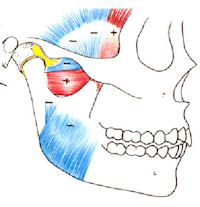 When the opening muscles contract (+), the closing muscles must release (-) in precisely timed coordination.
When the opening muscles contract (+), the closing muscles must release (-) in precisely timed coordination.
What is not generally understood, though there is voluminous research to corroborate it, is how comfortable jaw muscles can be aggravated into uncoordinated, uncomfortable muscles by a high filling, or deflective tooth inclines that interfere during jaw closure. Research on jaw muscle activity has shown that even minute bite interferences can activate severe problems of muscle incoordination and pain. The muscle hyperactivity often extends into the temporal region and produces headaches, and the muscle pain can be compounded by pain in teeth that interfere with jaw function
Muscle incoordination and pain can result from muscles working against each other. This type of muscle hyperactivity is triggered by bite interferences that require muscles to displace the TMJs in order to achieve complete closure of the teeth. Note that the jaw joint has to displace to make the teeth fit together.
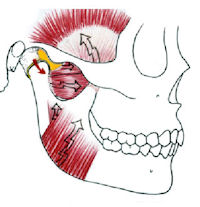 The exquisite sensitivity to bite disharmony results from one of the most extensive networks of sensory nerves in the body. This sensory system serves as a reflex protective system that programs the neuromuscular control for the jaw muscles.
The exquisite sensitivity to bite disharmony results from one of the most extensive networks of sensory nerves in the body. This sensory system serves as a reflex protective system that programs the neuromuscular control for the jaw muscles.
The vast network of sensory nerves in and around the teeth dictate avoidance patterns in the musculature to protect the teeth from overload. When avoidance patterns are prolonged, the muscles fatigue and become painful. Correction of the bite allows the muscles to return to comfortable, coordinated function.
 The effects of a bad bite vary from patient to patient. A person under stress tends to clench and grind the teeth and thus activates more severe muscle incoordination. But telling patients to just keep their teeth apart does not work, as much of the clenching is done during sleep. The best solution is to correct the disharmonies in the bite. With perfected bite harmony, the harm from clenching or grinding is minimized and pain levels are routinely eliminated or dramatically reduced.
The effects of a bad bite vary from patient to patient. A person under stress tends to clench and grind the teeth and thus activates more severe muscle incoordination. But telling patients to just keep their teeth apart does not work, as much of the clenching is done during sleep. The best solution is to correct the disharmonies in the bite. With perfected bite harmony, the harm from clenching or grinding is minimized and pain levels are routinely eliminated or dramatically reduced.
Treating occluso-muscle pain with pain medication is a popular approach but, except for short-term relief, is misguided. Pain medication may help reduce pain but it does nothing for slowing down damage from excessive tooth wear, loose teeth, fractured cusps and other obvious signs of malocclusion. Whenever possible to achieve, a harmonious bite and peaceful musculature is a far better choice than long-term use of medications for pain.

